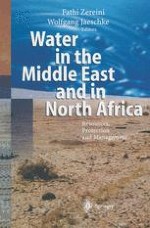2004 | OriginalPaper | Buchkapitel
Water Utilization in Semi-Arid Zone, The Hula Valley (Israel): Pollutant Removal, Agriculture and Ecotourism Management
verfasst von : Moshe Gophen
Erschienen in: Water in the Middle East and in North Africa
Verlag: Springer Berlin Heidelberg
Enthalten in: Professional Book Archive
Aktivieren Sie unsere intelligente Suche, um passende Fachinhalte oder Patente zu finden.
Wählen Sie Textabschnitte aus um mit Künstlicher Intelligenz passenden Patente zu finden. powered by
Markieren Sie Textabschnitte, um KI-gestützt weitere passende Inhalte zu finden. powered by
Until the late 1950’s the Hula Valley (altitude: 62.00–70.00 m above MSL) was covered by old Lake Hula (1.5 m mean depth; 13 km2 water surface), 3500 ha was a swampy area mostly covered by dense vegetation of Cyperus papyrus (85%) and partly by Phragmites australis (ca 10%) and the rest by different aquatic plants, including cattail (Typha domingensis). The swampy area was completely water-covered in winter and partly covered in summer The bottom sediments underneath the swamps vegetation were comprised of organic peat, nitrogen rich, under reductive conditions covered by water with low of oxygen content and probably anoxic during the night. The most common nitrogen form in Lake Hula waters and in the swamps was ammonia whilst nitrate was mostly below detection limit (Dimentman et al. 1992). Northern to the swamps there was an area (3200 ha) where water table levels were high in winter time, making agricultural development impossible. During summer periods, when underground water level declined these 3200 ha, were successfully (economically) cultivated.
